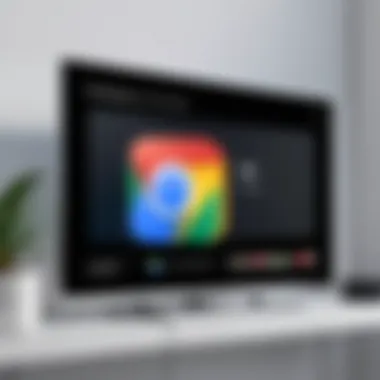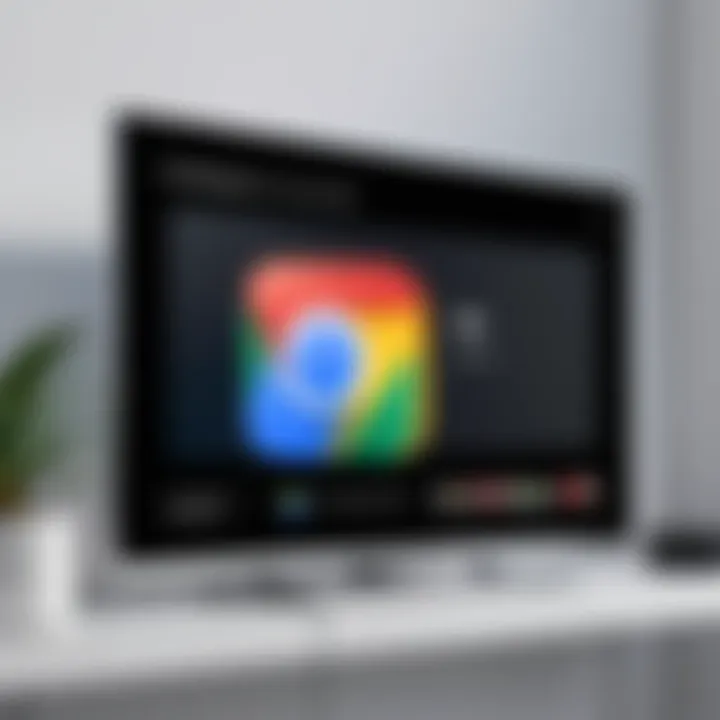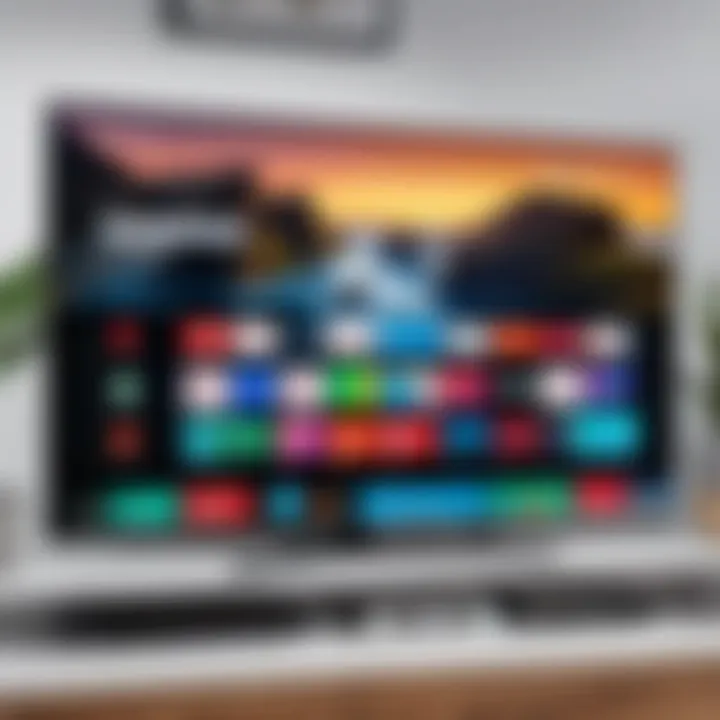Effortless Ways to Mirror Google Chrome to Your TV


Intro
Mirroring Google Chrome to your TV can enhance your browsing experience, enabling you to view content on a larger display. This ability is particularly advantageous for presentations, watching videos, or simply surfing the web with friends and family. In this guide, we will explore the various methods available to effectively mirror your screen, regardless of your device or platform.
Setting the Stage for Seamless Mirroring
Before diving into the methods, it is important to highlight a few prerequisites essential for a successful experience. Firstly, ensure that both your device (computer, smartphone, or tablet) and the television are connected to the same Wi-Fi network.
A stable network helps prevent lag and connectivity issues.
Additionally, ensure you are using the latest version of the Google Chrome browser. Updates often include critical performance improvements and features that enhance the mirroring process.
Navigating to the Mirroring Methods
There are several methods available to mirror Google Chrome to your television. Each method caters to different devices and user preferences. In the following sections, we will outline various methods, with detailed step-by-step instructions to facilitate easy navigation and implementation for users of all levels.
Method One: Using Chromecast
Chromecast stands out as a popular device for screen mirroring. To begin, ensure your Chromecast is plugged into the HDMI port of your TV and is powered on. Follow these steps:
- Open the Google Chrome browser on your computer or mobile device.
- Click the three vertical dots in the upper right corner to open the menu.
- Select Cast from the dropdown.
- Choose your Chromecast device from the list.
- Click on Sources and select Cast Desktop (or another relevant option).
- Select your TV to start mirroring immediately.
Method Two: Using Built-In Features of Smart TVs
Smart TVs offer various built-in features that could facilitate screen sharing. Ensure your television supports screen mirroring (e.g., Miracast or AirPlay). Steps may vary depending on the brand and model. Here’s a common outline of the process:
- Access the Screen Mirroring menu via the TV’s settings.
- On your computer or device, enable screen sharing or casting settings.
- Select your smart TV to begin the mirroring process.
Method Three: HDMI Cable
For those who prefer a wired solution, using an HDMI cable can provide reliable connectivity without Wi-Fi issues. Here’s how:
- Connect one end of the HDMI cable to your computer.
- Plug the other end into an available HDMI port on your TV.
- Make sure to switch your TV input to the correct HDMI source.
- Your computer screen should be mirrored onto the TV automatically.
Troubleshooting Tips
It is common to face hiccups during the mirroring process. If you can't see your screen on the TV, try the following tips:
- Ensure all devices are connected to the same Wi-Fi network.
- Restart your Chromecast or smart TV.
- Update the Google Chrome browser.
- Check HDMI connections for the wired method.
By following these steps, most common issues can be resolved quickly.
Alternative Methods
If the above methods do not work for you, alternative solutions such as third-party applications like ApowerMirror or AnyDesk may be considered. These apps allow cross-device mirroring, but it is advisable to research and review their performance and compatibility with your devices.
End
Prologue to Screen Mirroring
Screen mirroring is a powerful feature that connects devices to project screens onto larger displays. This method provides a practical solution for various scenarios, such as presentations, gaming, video streaming, and sharing photos or web pages. In the context of this article, mirroring Google Chrome brings numerous benefits that can enhance not only personal entertainment but also professional productivity.
Understanding Screen Mirroring
Screen mirroring allows a device to display its screen in real-time on another screen. This is typically accomplished over a wireless connection or through a wired method, depending on user preferences and available equipment. Such fluid connectivity promotes sharing information with others in a visual manner which is often more intuitive than merely verbal descriptions. The ability to project various types of content dramatically changes how we interact with devices and share experiences. With the range of applicable situations, understanding the core function of screen mirroring is vital to leverage its full potential.
Benefits of Mirroring Google Chrome


Mirroring Google Chrome carries notable advantages:
- Enhanced Viewing Experience: Users can transition from small device screens to larger displays, improving the visual quality of videos, presentations, or any web content.
- Ease of Collaboration: For professionals, sharing documents and presentations during meetings enhances communication. Everyone can view the same content simultaneously, leading to more engaging discussions.
- Access to Contents: Accessing vast content from the internet becomes effortless. With just a few clicks, it is no effort to share online articles, research, or resources with a larger audience.
- Flexible Usage: Depending on the technology and devices, users may choose wired or wireless methods suited to their specific contexts. This flexibility increases usability in diverse environments.
Mirroring makes screens an effective tool for interaction, connection, and presentation across many spheres of life.
In these ways, the process not only serves personal or entertainment goals but also broadens professional capabilities. Angst in longer, complicated presentations transforms into ease and efficiency. Thus, understanding how to leverage this capability lays the groundwork for delving into methods to mirror Google Chrome effectively.
Required Software and Apps
Lastly, reliable software or applications are needed for effective screen mirroring. Google Chrome itself must be up-to-date to ensure all casting features work promptly.
The important ones are:
- Google Chrome Browser: Make sure your browser is updated to avoid potential compatibility issues.
- Google Home App: Required in most setups for easy management of Google Cast devices.
There are also numerous third-party applications available if you wish to explore alternative paths. Research those carefully, as they might offer unique capabilities that enhance the mirroring experience.
Using Google Cast
Using Google Cast is a pivotal topic in the process of mirroring Google Chrome to your TV. This technology allows users to conveniently stream content from their devices to a larger screen without the hassle of cables. Google Cast, made available through devices such as the Chromecast, integrates various applications to facilitate seamless screen sharing. It serves as a link between your device and your television, offering flexibility for users to project everything from video content to entire webpages.
The main advantage of Google Cast is it provides wireless options, removing the limitations imposed by cables. Thus, You can move freely while your media plays, which makes it ideal for streaming sessions or presentations. With consideration to compatibility, Google Cast supports numerous platforms and applications, including all popular streaming services. Therefore enticing for both casual users and professionals needing to share their screens.
Did you know? Google Cast can mirror more than just browser tabs; it can also transmit music, photos, and documents.
This section will detail how to effectively set up and use Google Cast, mirroring content specifically through the Chrome browser.
Setting Up Google Cast
Setting up Google Cast is straightforward. Ensure the device is connected to the same Wi-Fi network as your TV. Download the Google Home app onto your smartphone or tablet. Then, ang the app will help walk you through the initial setup of the Chromecast or Google Cast-enabled device. After setup, your Google Cast device should prompt your TV through a display.
Once these steps are complete, you can enhance your experience by configuring personalized settings like device renaming through the Google Home app.
Mirroring through Chrome Browser
To start mirroring through the Chrome browser, you first need to open the Google Chrome browser on your device. Click on the three vertical dots found in the upper-right corner. From the drop-down menu, select
Using HDMI Cables
Using HDMI cables is a widely preferred method for mirroring Google Chrome to your TV. This connection format ensures high-definition video and audio quality, which is crucial when streaming content from your computer or device to a larger display. While other methods such as wireless mirroring exist, the reliability and performance of HDMI cables often make them the best choice for many users. The process is straightforward, providing a direct line that minimizes issues such as lag and buffering.
Selecting the Right HDMI Cable
When it comes to selecting an HDMI cable, quality matters. Different cables can support varying resolutions and refresh rates. Some important considerations include:
- Type of HDMI Cable: There are standard and high-speed HDMI cables. A high-speed cable is necessary for video with higher resolution, such as 4K graphics.
- Length: Choose a cable long enough to connect your devices without straining the connectors but not so long that it causes a mess or deteriorates signal quality over distance.
- HDMI Version: Understanding HDMI specifications helps. HDMI 2.0 and HDMI 2.1 are ideal for modern TVs, supporting higher bandwidths which is essential for devices running demanding applications like streaming.
It is advised to buy HDMI cables from well-known manufacturers to avoid potential complications arising from low-quality products.
Connecting Your Devices
The physical connection of devices through HDMI cables is simple but should be done carefully. Follow these steps:
- Power Off Devices: Before connecting anything, make sure both your TV and computer or device are powered off. This helps prevent any potential electrical issues.
- Identify HDMI Ports: Locate the HDMI ports on your devices. Most modern TVs include multiple HDMI ports, usually found on the back or side.
- Connect One End to the Computer: Insert one end of the HDMI cable into the HDMI output port of your device that is displaying Google Chrome.
- Connect the Other End to the TV: Insert the other end into an available HDMI port on your TV. Ensure it is pushed in firmly.
- Power On Devices: Turn on both the TV and your computer. Change the TV’s input channel to the corresponding HDMI port to see the display from your device.
Configuring Your Output Settings
After connecting the devices, you might need to adjust output settings to optimize performance. Here's how to do it:


- Access Display Settings: On your device, right-click on the desktop and select “Display settings.” This opens the configuration panel.
- Select Your Display Mode: You can usually choose between several display modes, such as Extend, Duplicate, or Second screen only. Selecting 'Duplicate' mirrors your screen on the TV.
- Resolution: Adjust the resolution according to your TV's specifications. If you're unsure, 1920x1080 is a standard resolution that displays well on most TVs.
- Refresh Rate: Check that the refresh rate is set appropriately. Most TVs support 60 Hz but may vary by model.
By following these steps, you will ensure that the connection between your device and TV is not just established, but optimized for the best viewing experience, allowing you to enjoy the content from Google Chrome in a more immersive way.
Using Screen Mirroring Features on Smart TVs
Using screen mirroring features on smart TVs plays a pivotal role in enhancing the overall experience of consuming content on a more expansive display. Modern smart TVs come equipped with various functionalities that facilitate seamless connectivity between devices, especially for users who are accustomed to using Google Chrome. The documenation presented here will help users maximize the capabilities of their devices while providing a fluid viewing experience.
Identify Smart TV Screen Mirroring Options
Most contemporary smart TVs have built-in options but that may vary by brand. Firstly, to utilize screen mirroring features, users should check for terms like Smart View, AirPlay, or simply Screen mirroring on their TV’s settings menu. Some common options include:
- Chromecast Built-in: This enables direct mirroring from Google Chrome effortlessly.
- AirPlay: Best suited for Apple devices, enabling mirrored content sharing to compatible screens.
- Miracast: A reliable choice for Windows and Android tegdevices that engage with WiFi Direct technology.
Be sure to update your TV's firmware regularly to access the latest features. Each option may have its procedures; reading the user manual or visiting the official website guides outlines tailored for distinct models can provide further insight. Achieving compatibility ensures unlocking the full potential of screen mirroring on smart TVs.[^1]
Connecting via Miracast
Miracast adds swiftness and efficiency in overcoming barriers that arise in screen mirroring scenarios. This technology utilizes a peer-to-peer Wi-Fi connection between your smart TV and other devices. Furthermore, Miracast features a strong point—elimination of a shared network dependency, which is beneficial as many households have suboptimal Wi-Fi coverage.
To connect via Miracast, follow the steps below:
- Check Compatibility: Ensure your smart TV and the device running Google Chrome are compatible. Most modern windows-based computers and Android devices usually support it.
- Enable Miracast on TV: Go to volume settings or sources, enabling mirroring.
- Access Devices on Your Phone or Computer: On your device, search for connected devices and select your mirror-device option. You should see a notification on the TV prompting connecting action simply.
- Select the device on Your Smart TV: After selecting it, watch the screen display as all activities on your device appear.
Connecting through Miracast shoots up an avenue where users generally do not have to fuss about router interference—it proves handy in densely constructed households.
It's vital to keep device software up to date, maximizing performance to streamline the mirroring experience, thus ensuring interactivity without roadblocks.
This section on using screen mirroring on smart TVs tempts tech users to explore functionality who otherwise may overlook them.
[^1]: For more detailed, documented options, refer to Wikipedia for insights on compatibility, specifications and steps.
Alternative Methods for Mirroring
In the evolving world of technology, knowing various methods to achieve tasks can make a notable difference. When it comes to mirroring Google Chrome to a TV, alternative methods serve as versatile solutions. These options provide flexibility, ease, and expandability to users who may not have access to conventional tools.
Using alternative methods can cater to a variety of scenarios. Some users may prefer specific software for its reliability, while others may have devices that utilize innovative features allowing mirroring without additional hardware. et pen
Using Third-Party Applications
Several third-party applications exist that break the dependency on built-in mirroring settings. Applications like AirDroid and ApowerMirror offer extensive features for showing your screen on a smart TV or any mirror-compatible device. These software tools allow clearer and easier management of how content is presented on larger screens.
- AirDroid: This desktop app worked seamlessly across a range of devices, allowing users to share their screens and files territorially. Getting started involves downloading the application from the official website and ensuring both your TV and device connect to the same Wi-Fi network.
- ApowerMirror: The versatility in ApowerMirror lies mostly in its ability to use USB for a connection. The application recognizes the device almost the moment of connection and presents customized mirroring options relevant to screen size.
"Exploring third-party apps for screen mirroring pays off when a quick ready solution is sought."
Though tempting, it's vital to consider device compatibility and security when selecting any third-party app. Review options carefully
Utilizing Built-in Features
Contemporary smart TVs often offer built-in screen mirroring capabilities. These native features can simplify the connection process, as users do not need to install additional applications or use extra cables.
- SmartShare: Found in LG smart TVs, this function supports multiple content types and is user-friendly.
- AirPlay: Apple's technology for mirroring works not only iOS devices but also available on many smart TVs. Once enabled, users can connect iPads or iPhones without fuss.
- Miracast: Many modern TVs integrate Miracast which enables peer-to-peer connections, offloading the need for routers or intermediate devices. For ease of use, simply access its settings and choose the one device for a smooth experience.
Altogether, built-in features display they are a worthwhile consideration when assessing methods that require minimal set-up and promise effective mirroring of Google Chrome on TVs. Thus far, getting familiar with all options remains important for getting an optimal mirroring experience.
Troubleshooting Common Issues
Understanding the common issues that may arise during the mirroring process is crucial for maintaining a seamless viewing experience. Troubleshooting allows users to identify and rectify potential problems that can interrupt or degrade the quality of screen mirroring. By addressing these common obstacles, such as connection problems, audio and video sync issues, and display quality concerns, users can ensure a reliable and productive interaction with their devices.


Connection Problems
Connection errors are often the first hurdle faced when attempting to mirror Google Chrome to a television. Several factors contribute to these issues, including unstable network signals, incorrect settings, or connection limits on the devices involved. Here are key points to consider:
- Check Network Stability: The strength and stability of the Wi-Fi signal are pivotal. Ensure that both your computer and TV are on the same Wi-Fi network.
- Restart Devices: Sometimes, a simple restart can remedy the errors. Unplugging and plugging back in your smart TV and router may help clear temporary issues.
- Update Software: Always ensure that your devices, including cast receivers, have the most recent updates. This can significantly affect compatibility and performance.
If these steps do not resolve the issue, try forgetting the network on your device and reconnecting it. Additionally, it can be helpful to toggle the casting toggle off and on within the Google Chrome settings to initiate a fresh connection.
Audio and Video Sync Issues
Audio and video sync problems can frustrate the viewing experience significantly. These discrepancies occur when the audio and visual components are out of alignment, resulting in a jarring experience. To troubleshoot this problem, consider the following:
- Content Source: Sometimes, the issue lies with the content being streamed rather than the devices. Testing different video sources helps isolate the problem.
- Adjusting Audio Delay: Some devices offer settings to adjust audio delays. If supported, exploring these could resolve sync problems.
- Restart Mirroring: Disconnect and reconnect the screen auditing. This step allows any lag in playback time to reset variables.
Maintaining consistent playback settings across devices can also minimize the likelihood of experiencing sync problems.
Quality of Display
Display quality heavily influences the overall enjoyment of screen mirroring. Resolution issues manifest in blurry images or limited quality output. The continuity of performance during mirroring can preserve a great viewing experience. Here are practices to enhance display quality:
- Network Speed: A slow internet speed can lead to poor quality output. It's wise to test and ensure that the connection is equal to what is needed for optimal screen mirroring.
- Resolution Settings: Verify the resolution settings in both Chrome and the output device. Adjust them to match and optimize during usage.
- Refresh Rate: Some devices allow the manipulation of the refresh rate. Choosing the appropriate refresh rate can lead to smoother transitioning without lag or frame drops.
Often, tweaking a few different settings yields the desired level of performance, delivering a display quality that matches the source material.
"Ultimately, investing time into troubleshooting ensures that the advantages of screen mirroring are fully realized, culminating in a smooth, efficient, effective viewing experience."
Best Practices for Effective Mirroring
Effective mirroring involves more than just getting two devices to connect. It requires an understanding of your network and how to optimize the set-up. By prioritizing best practices, users can achieve a smoother and more efficient mirroring experience. This section discusses how to ensure your Wi-Fi network is optimized and how screen resolution can be managed effectively.
Optimizing Your Wi-Fi Network
A stable Wi-Fi network is crucial for successful mirroring. Many mirroring problems stem from poor or inconsistent connections. To ensure you have a reliable network:
- Position your router correctly: Place your router centrally in your home. Avoid any physical barriers that could weaken the signal.
- Limit interference: Electronic devices like microwaves can affect Wi-Fi signal strength. Keep your router away from such devices.
- Check your bandwidth: If many devices are using the network at once, bandwidth can suffer. Try disconnecting unused devices.
- Use 5GHz band: If your router supports it, opt for the 5GHz frequency band for less congestion and faster transmission.
- Update your router firmware: Keeping your firmware up to date decides the performance of your device.
Following these strategies can greatly improve your mirroring performance, allowing for a more continuous and clear display on your TV.
Managing Screen Resolution
Screen resolution directly impacts the quality of mirrored content. If the resolution is not properly configured, you may experience a stretched or pixelated image, which detracts from the viewing experience. Here’s how to handle this:
- Select the right resolution on Chrome: Access Chrome's settings to adjust the display resolution that matches your TV’s native resolution.
- Enable Full Screen Mode: When mirroring, use the full-screen option in Chrome. This can provide a better aspect ratio or improved visuals.
- Make adjustments on your TV remote: Different TVs have various modes. Make sure to switch to the mode that corresponds to the input source you are using.
- Consider scaling options: Depending on the OS you are using, you may have options to scale the display differently. Higher scaling can make text and visuals clearer.
Adjusting display settings is a key factor that determines how well content appears on your screen. Ensuring that these factors are managed wisely enhances overall mirroring experience.
Effective mirroring is not just a function of capabilities, but also of environment. Optimal settings lead to wins in visual fidelity.
Culmination
In this article, we explored various effective methods for mirroring Google Chrome to your TV. The relevance of this topic stems from the desire for larger displays and enhanced viewing experiences. Today, users engage with content on different screens, making the ability to reflect Chrome browser tabs invaluable.
Summary of Key Points
- Understanding Screen Mirroring: We have discussed how screen mirroring functions, highlighting that it allows you to display content from your device directly onto your TV without requiring traditional cables tied to a setup.
- Software and Hardware Requirements: We established the prerequisite tools needed for successful mirroring, noting compatible devices and the essential network configurations.
- Various Mirroring Methods: The article detailed specific methods like using Google Cast for instant mirroring and via HDMI cables for clear, direct connections. Both methods cater to a variety of preferences and device compatibilities.
- Troubleshooting Guide: We addressed common issues, such as connection problems and display quality, which can arise during mirroring processes. Adhering to these troubleshooting tips can save time and effort.
- Best Practices for Effective Mirroring: Essential tips were shared, including optimizing one's Wi-Fi network and screen resolution for a clear presentation, enabling a more enjoyable viewing experience.
Future of Screen Mirroring Technology
The future of screen mirroring technology appears bright. With advancements happening in streaming and display technology, there is likely to be increased ease in connectivity and enhanced performance.
- Developments in Wi-Fi Standards: As new Wi-Fi standards observe faster data transfer rates, users will experience smoother streaming without delays or lags.
- Emergence of Wireless Protocols: Innovative wireless protocols may enable even more seamless connections between devices. This potential improvement can make setup more user-friendly and further minimize technical barriers.
- Increased Compatibility: Future iterations of smart devices are expected to have consistent software updates. This includes cross-compatibility between various OS types, improving wideness in application functionality and reach.
While there remain certain limitations with existing technologies, the ongoing developments reflect the tech industry's push towards simplyfing screen interaction. It emphasizes the important role of apps and systems that respond to users' needs should they exist across varied frameworks.
Embarking on a poignant digital journey through mirror display provides remarkable opportunities for enjoyment and productivity. Remain alert to this ever-evolving tech landscape for next-level possibilities.



